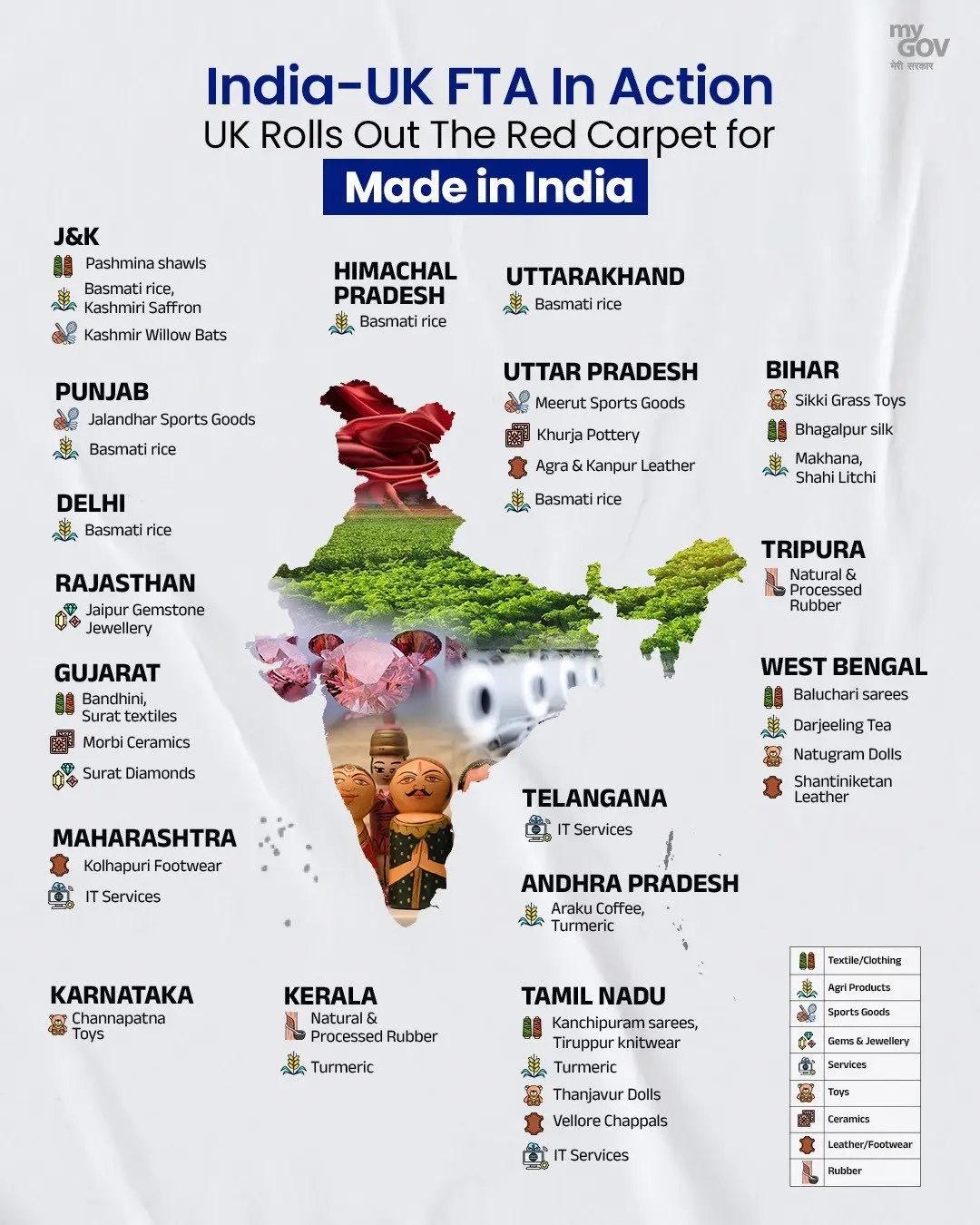The India–UK Free Trade Agreement (FTA), signed on July 24, 2025, marks a transformative moment in international trade. After more than three years of negotiations, this comprehensive trade pact is set to reshape the economic relationship between India and the United Kingdom. It is India’s first full-scale FTA with a European nation and one of the most significant bilateral trade agreements signed by the UK in the post-Brexit era.
Overview of the India–UK FTA
The agreement is designed to promote bilateral trade, reduce tariffs, streamline customs procedures, and improve market access for goods and services. With implementation expected in mid-to-late 2026, the FTA is projected to boost annual trade between the two nations by £25.5 billion (approximately USD 34 billion) by 2040.
Key Provisions of the India–UK Free Trade Deal
- Zero-duty access for 99% of Indian exports to the UK
- Tariff reductions on 90% of UK goods exported to India
- Mutual access in sectors such as textiles, automobiles, beverages, pharmaceuticals, financial services, and IT
- Improved mobility for skilled professionals and cultural workers
- Provisions for digital trade, investment protection, and customs cooperation
Key Benefits of the UK-India Trade Deal
Significant Tariff Reductions
- British Whisky and Alcohol: High tariffs on UK whisky will be reduced from 150% to 75% right away, and further cut down to 40% over ten years.
- Automobiles: Duties on British cars exported to India will be lowered from over 100% to just 10%, phased in gradually under a set quota.
- Other UK Exports: Items such as gin, aerospace, and electrical machinery will also see customs duty reductions, provided they meet minimum value thresholds.
Expanded Access for Indian Exports to the UK
- Textiles, Footwear & More: 99% of Indian exports—including textiles, gems, footwear, and agricultural products—will enter the UK duty-free or at significantly reduced tariffs.
- Food Products: The UK will eliminate tariffs on up to 99.7% of Indian food export categories, boosting India's food export industry.
New Opportunities in Services and Professional Mobility
- Work Visas: Indian professionals in IT, consulting, hospitality, and more can benefit from streamlined visa processes and expanded work opportunities in the UK.
- Social Security Relief: Indian workers in the UK will not pay double social security contributions, making short-term work stints more cost-effective.
Improved Public Procurement & Regulatory Procedures
- Access to Indian Government Tenders: UK companies can bid for select Indian public procurement projects.
- Simplified Regulations: New measures aim to reduce technical barriers and streamline regulatory approvals, enabling smoother trade operations.

Credits: MyGov India
Trade Facilitation and Regulatory Reforms
The agreement also establishes:
- Rules of Origin standards to ensure fair trade practices
- Modernized customs processes for faster clearance
- Enhanced cooperation in intellectual property, dispute resolution, and sustainable trade
- A renegotiation clause allowing future amendments in line with evolving global trade conditions
Projected Economic Impact of the UK-India Free Trade Agreement
- Boost to Bilateral Trade: The FTA is projected to increase annual UK-India trade by £25.5–34 billion.
- Trade Target: Both countries aim to expand bilateral trade volume from $21.9 billion (2024) to $120 billion by 2030.
- Global Influence: This agreement sets a precedent for India’s trade negotiations with other developed nations and may influence future FTAs.
Why is the UK-India FTA Important?
For the UK
- Opens new avenues for British exporters post-Brexit.
- Enhances access to one of the largest and fastest-growing markets globally.
For India
- Strengthens global standing and sets the stage for future agreements, including possible talks with the European Union.
- Enhances access for Indian goods and services in the British market.
For Businesses and Professionals
- Encourages new investments and partnerships.
- Reduces costs, expands market reach, and streamlines compliance for exporters and skilled professionals.
Next Steps and Implementation Timeline
The FTA now awaits ratification by the respective parliaments. Upon approval, the agreement is expected to come into force in the second half of 2026, with tariff reductions and market access provisions phased in over a ten-year period.
Conclusion: A Strategic Win for Both Nations
The India–UK Free Trade Agreement 2025 is a forward-looking deal that enhances trade, promotes investment, and strengthens economic ties. Businesses in both countries stand to benefit from reduced costs, wider market access, and simplified trade procedures. As global supply chains evolve, this agreement positions India and the UK as key partners in a competitive, rules-based trading environment.
Companies involved in exports, imports, manufacturing, finance, and IT services should begin preparing for the upcoming changes to take full advantage of this historic trade opportunity.
Ready to Maximize the Benefits of the India–UK FTA?
Whether you're an exporter, importer, startup, or multinational, understanding the tax implications, documentation requirements, and trade strategies under the India–UK Free Trade Agreement is essential.
to stay ahead of the curve and unlock global trade opportunities.